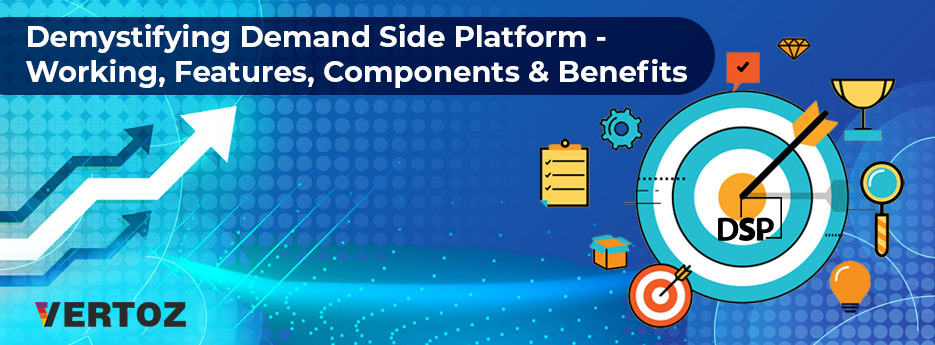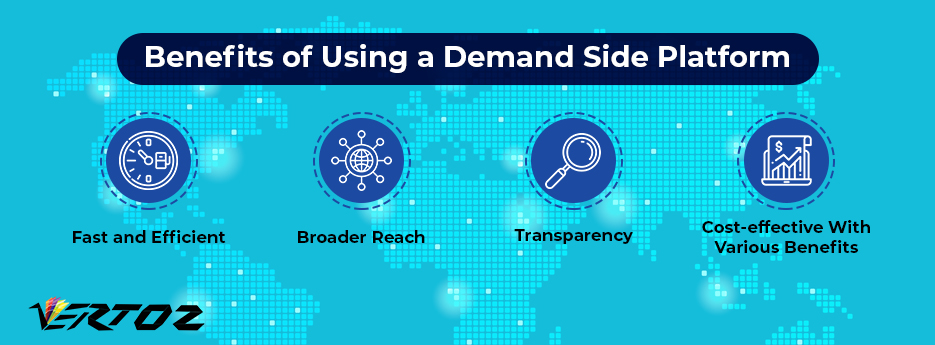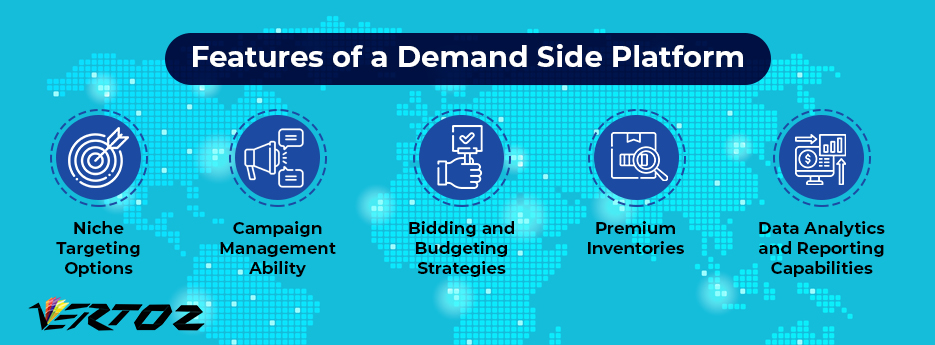
What is a Demand Side Platform?
DSP (Demand Side Platform) is a software used by advertisers to buy ad inventories across various formats programmatically. It automates the whole process with the help of RTB and allows buying ad inventory in the real-time.
Advertisers buy the available ad inventories from SSPs, i.e, supply-side platforms, also known as publishers. Ad-exchange acts as a mediator in this whole process, as both DSPs and SSPs are connected to an ad-exchange.
The primary difference between a DSP and independent networks like Google, Facebook or LinkedIn is that with a DSP an advertiser can buy ad inventories like search, display, mobile, native, etc via a single platform.
How Does A Demand Side Platform Work?
 The working of DSPs is, however, an elaborate and a technical process, but here’s a brief look at how they function-
The working of DSPs is, however, an elaborate and a technical process, but here’s a brief look at how they function-
A DSP is typically connected to an ad exchange where many publishers provide various types of ad inventories available to them via SSPs, i.e. Supply Side Platforms. An SSP is to publishers what a DSP is to advertisers. An advertiser sets up the targeting criteria, budgets and ad creatives with the help of the DSP they are connected with.
Suggested Read: Difference Between Ad Network and Ad Agency
The process of buying an ad inventory takes place as soon as a visitor lands on a page. Information about the history and preferences of the visitor is sent to the ad exchange which is then communicated with the DSP. A DSP then looks for relevant ads available and the bidding process begins through the process of Real-Time Bidding (RTB) among advertisers to buy that available inventory to show their ad to the visitor. The highest bidder wins the auction and gets to display its ad. And this entire process takes place within 100 milliseconds!
Benefits of Using a Demand Side Platform

1. Fast and Efficient
Being a technology-driven platform, DSP enables efficiency in reaching out to the desired prospects, certainly faster than the traditional media buying process and hence helps to eliminate manual errors.
2. Broader Reach
As DSPs work in coordination with SSPs and also helps you get connected with various ad exchanges. This provides advertisers with a plethora of options available to reach their prospects in a real-time. Add to this increased relevancy and proper context that keeps getting updated constantly.
3. Transparency
DSPs provide detailed and transparent data regarding the campaigns you run and enable better understanding with comprehensive analysis. Because the data is fetched in real-time, you can be assured of not having to work based on outdated information and running a thorough check on which of your campaigns are working well or otherwise.
4. Cost-effective With Various Benefits
Using a DSP to manage, run and analyse your campaigns digitally is economical in many ways. Besides, there are other benefits added to it like detailed targeting options available, campaign management, real-time analysis, easy to use interface, etc.
Features of a Demand Side Platform

Although the features of a DSP may be different depending upon their type and company, below are some of the features that a DSP must offer.
1. Niche Targeting Options
DSP enables various audience targeting options based on demographic, location, device, behaviour, context, etc. With fierce competition and tight budgets, advertisers need to be picky about the money they spend on advertising and with such niche targeting capabilities, they can only show their ads to the users they choose.
2. Campaign Management Ability
DSP allows advertisers to manage their campaigns effortlessly via one platform wherein they can also store their creatives and anything they need to run a particular campaign. Because a campaign is run with multiple ad exchanges, having everything in one place helps advertisers to take proper decisions.
3. Bidding and Budgeting Strategies
Although a DSP automates the whole process of auctioning, options like fixed price, variable price, etc can train it to make better decisions. Apart from that, various other options like day budget, overall budget, etc integrated into DSP help advertisers optimise their spendings to the best.
4. Premium Inventories
Premium inventories are those inventories that are deemed to be of a higher quality and are sold at a relatively higher price. Access to such inventories enables advertisers with a multitude of options to make their presence on such inventories when a DSP has partnered with such ad exchanges.
5. Data Analytics and Reporting Capabilities
DSPs help advertisers to manage and analyse third-party data and thereby better their targeting decisions. Additionally, with better reporting capabilities, advertisers can examine their campaigns across multiple ad exchanges.
Components of a Demand Side Platform

The infrastructure of DSPs varies from company to company and type to type, although, here are some basic elements that form the framework of a DSP.
1. User Interface (UI)
User Interface is the look and feel of a DSP platform, something that the advertiser sees while managing an ad campaign. For eg – analysis, reports, creative management, budget, etc.
2. Ad Server
An ad server serves as a repository for creatives and ad markup. Its role is to prevent ad frauds and decide the best price per impression. The ad server also supplies the ad creatives to the publisher’s website and keeps a track on the conversion data.
3. Bidder
The bidder examines the inventories offered by SSPs and puts the right bid amount in the RTB auctions. It predicts the value of an inventory based on the data, traffic and the ad CTR.
4. Data Platform
The data platform notes the interactions between the bidder and the ad server. It is capable of integrating an external DMP (data management platform) to enhance the profiles of the users.
5. User Profile and Reporting Database
User profile saves the details of the users like their conversion history, preferences, characteristics, etc. It plays a vital role during retargeting. Reporting database combines the performance data of the campaign and places the reports on the UI dashboard for easy access.
6. Campaign Tracker
Campaign tracker examines the performance of the campaign on metrics like bidding price, win rate, impressions, cost per impressions, click-through rate, etc. This data is then sent to the reporting database.
To conclude, note that the primary role of a DSP is to ease the efforts of marketers with the help of technology like AI and ML. Although there may be occasional complexities or it may appear to be overwhelming at first, it offers a multitude of advantages like maximum ROI by making optimum use of the set budget, efficient use of data and more.
To see how Vertoz’s IngeniousPlex can help you with your advertising campaigns, request a demo by writing to us at mktg@vertoz.com.

